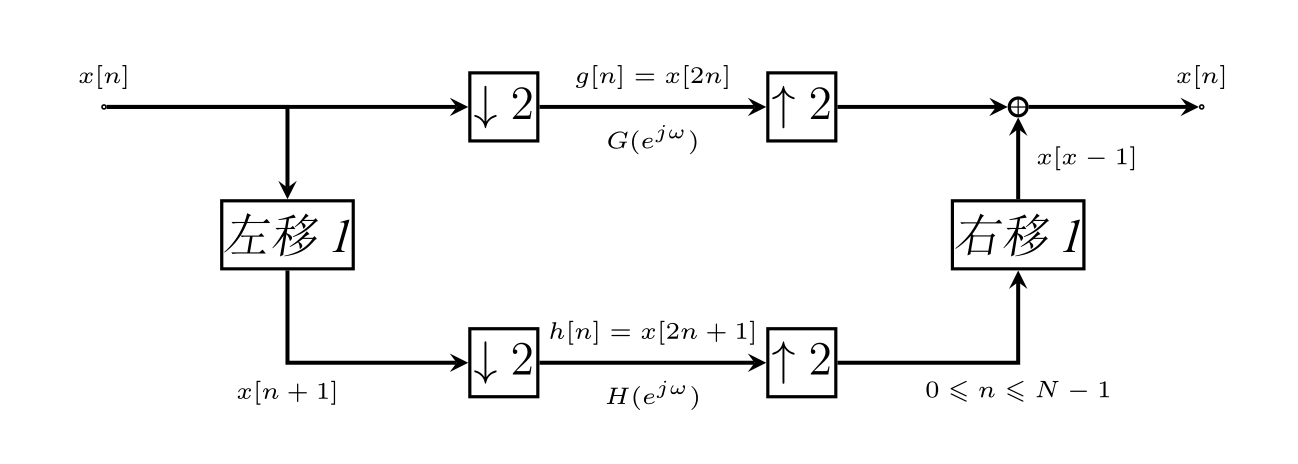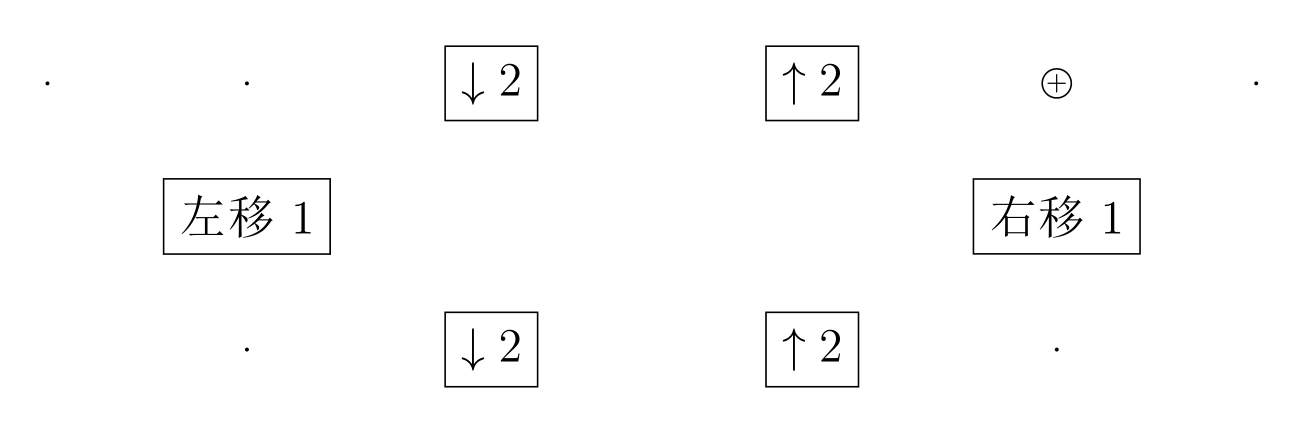1
2
3
4
5
6
7
8
9
10
11
12
13
14
15
16
17
18
19
20
21
22
23
24
25
26
27
28
29
30
31
32
33
34
35
36
37
38
39
40
41
42
43
44
45
46
47
48
49
50
51
52
53
54
55
56
57
58
59
60
61
62
63
64
65
66
67
68
69
70
71
72
73
74
75
76
77
78
79
80
81
82
83
84
85
86
87
88
89
90
91
92
93
94
95
96
97
98
99
100
101
102
103
104
105
106
107
108
109
110
111
112
113
114
115
116
117
118
119
120
121
122
123
124
125
126
127
128
129
130
131
132
133
134
135
136
137
138
139
140
141
142
143
144
145
146
147
148
149
150
151
152
| \documentclass{article}
\usepackage{tikz}
\usetikzlibrary{arrows,graphs,decorations.markings}
\begin{document}
\pagestyle{empty}
% 辅助计数器
\newcounter{x}
\newcounter{y}
\begin{tikzpicture}[
yscale=.5,
xscale=1.5,
%node distance=1cm,
auto,
> = stealth,
-> /.style={thick, black},
-- /.style={thick, black},
->-/.style={decoration={
markings,
mark=at position #1 with {\arrow{>}}},
postaction={decorate}},
n/.style={
circle,
draw,
minimum size=2pt,
inner sep=0pt,
outer sep=0pt},
]
% The strategy is to create nodes with names: N-column-row -> N-列-行
%----------------------- 输入输出 -------------------------------------------------------
% 输入结点命名规则 N-0-0 ... N-0-15
% 输出结点命名规则 N-8-0 ... N-8-15
% Draw inputs
\foreach \y in {0,...,15}
\node[n,pin={[pin edge={<-}]left:$x[\y]$}]
(N-0-\y) at (0,-\y) {};
% Draw outputs \y计数 idx显示
\foreach \y / \idx in {0/0,1/8,2/4,3/12,4/2,5/10,6,7/14,
8/1,9,10/5,11/13,12/3,13/11,14/7,15}
\node[n, pin={[pin edge={->}]right:$X[\idx]$}] (N-8-\y) at (6,-\y) {};
%-------------------------- 画连接点 ---------------------------------------------------
% 0 1 2 3 4 5 6 7 8
% in o - o o - o o - o - o out
% 7个中间连接点
\foreach \y in {0,...,15}
\foreach \x / \c in {1/1, 1.5/2, 2.5/3, 3/4, 4/5, 4.5/6, 5.5/7}
\node[n] (N-\c-\y) at (\x,-\y) {};
%----------------------- 画连接线 -----------------------------------------------------
% 水平线连接
\foreach \y in {0,...,15}%行
\foreach \x in {0,2,4,6}%列
{
\setcounter{x}{\x}\stepcounter{x}
\path (N-\x-\y) edge[->-=.87] (N-\arabic{x}-\y);
}
\foreach \y in {0,...,15}%行
\foreach \x in {1,3,5,7}%列
{
\setcounter{x}{\x}\stepcounter{x}
\path (N-\x-\y) edge[->-=.5] (N-\arabic{x}-\y);
}
% 斜线连接
\foreach \sourcey / \desty in {0/8,1/9,2/10,3/11,
4/12,5/13,6/14,7/15,
8/0,9/1,10/2,11/3,
12/4,13/5,14/6,15/7}
\path (N-0-\sourcey) edge[->-=.04] (N-1-\desty);
\foreach \sourcey / \desty in {0/4,1/5,2/6,3/7,
4/0,5/1,6/2,7/3,
8/12,9/13,10/14,11/15,
12/8,13/9,14/10,15/11}
\path (N-2-\sourcey) edge[->-=.97] (N-3-\desty);
\foreach \sourcey / \desty in {0/2,1/3,2/0,3/1,
4/6,5/7,6/4,7/5,
8/10,9/11,10/8,11/9,
12/14,13/15,14/12,15/13}
\path (N-4-\sourcey) edge[->-=.95] (N-5-\desty);
\foreach \sourcey / \desty in {0/1,1/0,2/3,3/2,
4/5,5/4,6/7,7/6,
8/9,9/8,10/11,11/10,
12/13,13/12,14/15,15/14}
\path (N-6-\sourcey) edge[->-=.3] (N-7-\desty);
%----------------------- 标注旋转因子 -----------------------------------------------
% W_16
\setcounter{y}{8}
\foreach \i in {0,...,7}
{
\path (N-1-\arabic{y}) edge[->-=.5] node {\tiny $W^{\i}_{16}$} (N-2-\arabic{y});
\node[below] at (N-1-\arabic{y}.south) {\tiny -1};
\stepcounter{y}
}
% W_8
\setcounter{y}{4}
\foreach \j in {1,2}
{
\foreach \i in {0,2,4,6}
{
\path (N-3-\arabic{y}) edge[->-=.5] node {\tiny $W^{\i}_{16}$} (N-4-\arabic{y});
\node[below] at (N-3-\arabic{y}.south) {\tiny -1};
\stepcounter{y}
}
\addtocounter{y}{4}
}
% W_4
\setcounter{y}{2}
\foreach \j in {1,...,4}
{
\foreach \i in {0,4}
{
\path (N-5-\arabic{y}) edge[->-=.5] node {\tiny $W^{\i}_{16}$} (N-6-\arabic{y});
\node[below] at (N-5-\arabic{y}.south) {\tiny -1};
\stepcounter{y}
}
\addtocounter{y}{2}
}
% W_2
\setcounter{y}{1}
\foreach \j in {1,...,8}
{
\foreach \i in {0}
{
\path (N-7-\arabic{y}) edge[->-=.5] node {\tiny $W^{\i}_{16}$} (N-8-\arabic{y});
\node[below] at (N-7-\arabic{y}.south) {\tiny -1};
\stepcounter{y}
}
\addtocounter{y}{1}
}
\end{tikzpicture}
\end{document}
|


